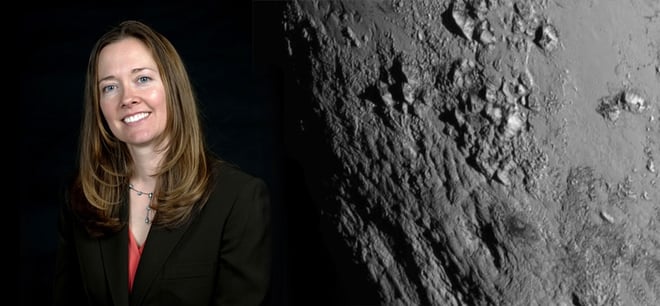Engineer Q&A: How To Get A Job At NASA
Rebecca Benison July 16, 2015
On the heels of the successful Pluto flyby, one thing that remains clear is that the American public is still as excited as ever about outer space discoveries.
Not only that, but many of the key figures involved in NASA’s missions today are female. As we continue to make strides in the field of science, it seems we’re also making strides to close the gender gap, one flyby at a time.

Behind the scenes, there’s a lot that goes into each successful mission. In fact, there are many indirect players who are working on new technologies and concepts on a daily basis to quench our curiosity of the unknown.
Jennifer Cole, Chief of the Aerodynamics and Propulsion Branch at NASA’s Armstrong Flight Research Center is one such player.
After earning a B.S. in Aerospace Engineering from Penn State University, Ms. Cole worked her way up through the ranks to her current position as branch chief. She directly supervises about 21 full-time engineers, 2-3 engineering students depending on the time of year, and indirectly manages about 10 contractors. Below, we discuss her journey from aerospace enthusiast to aerospace engineer.
RB: What led you to aerospace engineering?
JC: I’ve always enjoyed aviation and airplanes, and was aware of the space program. I was 9 when the Challenger accident occurred, which is etched in my mind to this day. I wanted to be a military pilot and fly fast airplanes, but my eyesight wasn’t up to par. Always interested in and pretty good at math and science, I was dissuaded from pursuing engineering as a college major by a high school guidance counselor, because the job market at the time wasn’t good. It only took one semester, and a robotics course at Penn State, to sway me towards engineering. Given my perpetual interest in all things aviation, aerospace was a good fit.
RB: Were there any notable mentors in your education or early career?
JC: I remember my high school astronomy teacher, Mrs. Wakefield, who challenged her students with creative approaches to learning about astronomy and the world outside the Earth. She was so enthusiastic, very witty, and kept our attention. I learned a lot in her class, and I’m now teaching my kids about the moon phases, constellations, and eclipses. I recall my college mentor and advisor, Dr. Maughmer, who is the one who ultimately steered me to NASA Dryden Flight Research Center [now known as NASA Armstrong]. He was a good listener, and always had a good story or two to share to give me perspective on whatever I was going through. Once at NASA, I had numerous mentors, many of whom I still refer to.
RB: What are some of the biggest challenges you face in your current position?
JC: In my current position, the biggest challenges stem from making the most with what we have, in terms of people, time, budgets and other resources. We have so much great work, and a tremendous workforce full of motivated, brilliant people. Most of what we do involves numerous other branches and organizations. Balancing the various project needs and when they need them, with the people who have the appropriate skill set, is a rather complex optimization challenge. To be honest, it’s a great challenge to have.
RB: What has been your greatest career highlight so far?
JC: That’s a tough question to answer. The two things that come to mind are my current position as branch chief, as well as a role I held about 10 years ago, serving as a project chief engineer. The chief engineer role involved bringing together a small, brilliant team of engineers and pilots to develop a set of procedures on how to control and land an aircraft using only the engines. It was a concept called Throttles Only Control. We developed the procedures in various simulators, then tried them out using regular airline pilots, flying in actual airplanes. It was a great challenge, and a lot of fun working with such a diverse group of people. As for my branch chief role, it’s been such a huge learning experience, and supremely gratifying. I have the responsibility to ensure our engineers have what they need to accomplish the mission, and I have the authority to help make it happen. It’s a tremendous responsibility, and I love it.
RB: What do you want other people to understand about your field?
JC: That you don’t require a certain personality to be good at engineering. The basics are math, science, and understanding how things work. If you enjoy those areas, there’s a good chance you’ll enjoy engineering. Yes, the college courses are hard. But you’re learning how to learn. Give it everything you have. The best places to work will recognize your strengths and provide you with opportunities to leverage them, as well as develop you in other areas.
RB: Any advice for students, or young people in general who are interested in engineering?
JC: Get experience working in engineering fields well before you graduate! Look for jobs in your desired area, but don’t be afraid to branch out. Even if the experience isn’t what you thought it would be, the experience will most likely help you make career decisions. And don’t be too worried about delaying your graduation as a result of direct experience working in an engineering field. It makes you more well-rounded as an engineer.
Today, there are so many opportunities for interested students to pursue STEM (Science, Technology, Engineering, and Math) subjects. In addition to new programs being introduced in classrooms across the country, NASA itself is working to foster a love of learning among young people. After becoming the first person to complete the NASA Passport Program, 14-year-old Alyssa Carson has been encouraged to pursue her dream of becoming one of the first Mars explorers. She’s been invited to speak on panels alongside senior scientists and an astronaut, and even spoke to an audience of about 500 children. By getting more people involved in the process at a young age, NASA is paving the way for future discoveries and expeditions. To stay updated on the latest research and initiatives at NASA Armstrong, follow them on Twitter.
Additional Thomas Resources To Land Your Dream Job In The Industrial Sector:
- 7 Reasons It's Great To Work In Manufacturing
- 3 Steps To Building A Career As A Successful Woman In Industry
- Working In Manufacturing As A Millennial
- 5 Tricks To Answering Curveball Interview Questions To Land Your Dream Job
- 6 Ways To Become An Asset To Your Organization [Confessions of an Industry Millennial]
- Top 4 U.S. Manufacturing Challenges And How To Overcome Them
- 7 Manufacturing Newsletters To Subscribe To Today
Did you find this useful?




.png)



